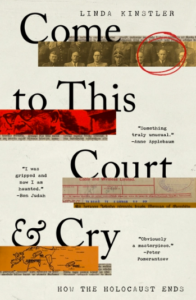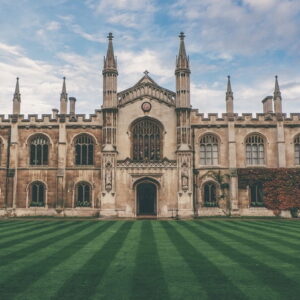
The History of Riga’s “Little Nuremberg” Trial
Linda Kinstler on Paranoia and Justice in Soviet-Occupied Latvia
My mother forwards me a video on WhatsApp. The app warns me that it has been forwarded many times, that it might be spam. It has been circulating among her emigre friends, bouncing from Riga to Tel Aviv to Düsseldorf to Boston and beyond. I click and out comes the sound of a triumphant marching band and the booming voice of a German newscaster: “For the third time since 1917, German troops arrive in Riga. This old city with seven hundred years of history has repeatedly shown its close connection to German culture. The invasion of our troops was greeted with jubilation from the people.”
It appears to be a scene from July 1941, but the newsreel is undated. Crowds of civilians line the streets, they wave at the processing German soldiers and heil their new leaders. Riga has been liberated, the announcer declares. Latvian flags wave, women and children wear traditional dresses, they smile and laugh. A Wehrmacht officer cracks open a beer, onlookers pass around a block of bread and butter.
Suddenly the video cuts to another crowd, standing on the same streets, only three years later. The same victorious music plays, and this crowd, too, smiles and waves, though there are no Latvian flags, no traditional dresses. This time it is the Soviet army processing through the streets. This time, men and women occasionally interrupt the orderly lines of soldiers to deliver kisses and bouquets. “For three years, the citizens of Riga have been awaiting this meeting,” a Russian announcer declares. “Riga has been returned to the Soviet nation.”
The video invites viewers to look at the faces in the crowd and wonder: which smiles are genuine, and which are fake? Which parade is the happier one? It acknowledges the ugly fact that both occupying armies received their own parades. That no one in either welcoming party knew what was to come. When I ask my mother about this video, she mentions that as a young boy, my father took part in a re-enactment of the Soviet victory parade for a state-sponsored historical film. He played another version of himself, a good young communist cheering and carrying the red flag.
The Soviets arrived wanting to take their own kind of revenge. Well before the war was over, they began putting Nazi collaborators and officers on trial.
In 1944, after that second happy parade, the atmosphere in Riga was thick with paranoia. One occupying power had been traded for another. “The weather, streets, and homes were all gray. People’s faces were gray. In the liberated city, a strange way of life took hold,” writes Musya Glants, who was ten years old at the time. “It seemed that those who had survived the occupation of Riga were hiding behind blacked-out windows. Different people, with different fates, all had the feeling that nothing good would come of the new occupiers.”
Latvians remembered the horrors and deportations of the first Soviet occupation, and had good reason to fear that the second time around would be worse. Many of those who had stayed in Latvia went into exile, and those who had been exiled and interned returned to stay. One Jewish survivor, Frank Gordon, told me that he had heard of cases in which “young Latvian women invited Soviet officers to their apartments, gave them alcohol to drink and later killed them.”
I do not know if this is a true story, but perhaps the fact that it has lived on as a revenge fantasy tells us all we need to know. The Soviets arrived wanting to take their own kind of revenge. Well before the war was over, they began putting Nazi collaborators and officers on trial. The proceedings were called show trials, yet there was a kind of justice to them. It was an ugly, perhaps perverted and certainly abbreviated approach to justice. And yet it was a kind of justice all the same.
The Soviet trials were the first to publicly expose the nature of the crimes that were still ongoing, and the obedient, thoughtless nature of the criminals. The Soviets had been preparing for these procedures for some time, collecting evidence of Nazi crimes under the auspices of the “Extraordinary Investigative Commission into the Crimes Committed by the German Fascist Invaders and their Collaborators,” comprised of 5,000 sub-commissions spread throughout the formerly occupied territory. Officers of the Extraordinary Commission interrogated bystanders, witnesses, survivors; forensic experts were dispatched to mass graves. Some of the Commission’s accounts contain wild fabrications and exaggerations, often tripling the already horrifying number of victims. These embellishments would make it easier, later, for Western prosecutors to discount the many truths these reports also contained.
At a computer in the US Holocaust Memorial Museum, I scroll through the commission’s reports from Latvia. Some are barely legible, handwritten accounts, documenting the days and hours of the “Aktions,” how the SS and their functionaries organized and transported their victims. One witness underlines the names Arājs and “Cukurs.” There are accounts from every town, neatly digitized and organized in a drop-down folder. The volume overwhelms.
When the novelist Daša Drndić sat before the same state files, looking at testimonies from other territories and towns, she was overcome not by what they documented, but by how much. “Everything is written in these documents: there is a record of every theft of other people’s belongings… whose house was plundered, who carried out the theft and when, what was taken, and, in some cases, what fate the victims met,” she writes. “In other words, it is all known. It is known.”
In July 1943, eleven Soviet traitors were put on trial in Krasnodar, a city in southern Russia near the coast of the Black Sea. It was a quick proceeding—in this first trial, it was only their own citizens who were being sentenced and judged, yet it laid the groundwork for the trials to come. The state prosecutor ended his closing statement with this rallying cry: the “court of history” would deliver its verdict on the fate of the “traitors, fascist hirelings, and bootlickers” on trial. “Not one of them will escape stern retribution! Blood for blood, death for death!” Eight defendants were hanged before an applauding crowd in the city square, the execution filmed, photographed and distributed globally.
In October 1943, the Allied powers signed the Moscow Declaration, agreeing that Germans who had participated in atrocities would be put on trial wherever their crimes had been committed. Over the next two months, British Prime Minister Winston Churchill tried to push his cabinet towards adopting a harsher approach, arguing for the creation of a kill list of “Hitler and Mussolini gangs and the Japanese war lords,” who could be shot without penalty. Any of the criminals who fell into Allied hands, he suggested, would be identified by a “Court of Inquiry” and then “shot to death within six hours and without reference to higher authority,” allowing their captors to sidestep the messy ordeal of an international trial. The “kill list” was not adopted, but its vengeful sentiment lingered on.
Once the Moscow Declaration was adopted, the Soviets wasted no time putting it to work: in Kharkov, the second largest city in Ukraine which, until 1934, had been the capital of the Ukrainian Soviet Socialist Republic, they organized a war crimes trial designed for international consumption. In December 1943, three Germans and one Soviet traitor stood beneath the Klieg lights of the Kharkov Drama Theatre and pleaded guilty to unspeakable crimes, to having participated in the systematic execution of the city’s “peaceful Soviet citizens.” From the press box, the celebrated Soviet writer Ilya Ehrenburg rejoiced at the momentousness of the trial’s opening day, the first day of the first war crimes trial held by any one of the Allied powers:
I waited a long time for this hour. I waited for it on the roads of France… I waited for it in the villages of Belarussia, and in the cities of… Ukraine. I waited for the hour when these words would be heard: “The trial begins.” Today I heard them. The trial commences. On the dock, beside a traitor, three Germans. These are the first. But these are not the last. We will remember the 15th of December—on this day we stopped speaking about a future trial for the criminals. We began to judge them.
The Kharkov trial began with four guilty pleas and ended, four days later, with four public hangings. It was a dramatic affair, a spectacle that was once again filmed and distributed across the Soviet Union, Britain and the US: the judges, prosecutor and attendants all in uniform, seated upon the illuminated stage; the mezzanine and orchestra packed; the wheels of justice grinding into motion. The Soviets saw the Kharkov trial, like the Krasnodar trial before it, as a model for all that was to come, the first instance of “the great trial which shall be held of all Hitler’s thugs,” as the writer Konstantin Simonov put it; the first attempt to try Nazi soldiers and collaborators according to “the laws and norms of international law.”
Footage of the trial shows the audience in rapt attention; women in floral headscarves, men in Soviet military uniforms taking in the confessions of the accused. From his own perch in the press box, the American journalist Edmund Stevens noticed that “many of the people in the audience had personal knowledge or experience of the events and atrocities described, and had seen or known the defendants during the German occupation. Several times during more gruesome bits of evidence there were stifled sobs from some woman—not out of pity for the defendants.”
In this sense the trial had something in common with the earliest juries of medieval England, when “jurors were for a time selected based on their pre-existing knowledge of the case and their familiarity with the defendants.” For the audience at Kharkov, the crimes for which the defendants stood accused were painfully fresh. The women of my mother’s large Jewish family had been evacuated from the city in 1941, along with all the employees of my great-aunt Dora’s manufacturing plant. (Their male relatives all joined the army.) They ended up in Shymkent, Kazakhstan, with thousands of Soviet families. I wonder what they would have thought had they been in the audience that day; but then again, if they had not been evacuated, they would have already been dead.
The defense counsel at the Kharkov trial pleaded for a more lenient sentencing on the grounds that “these men were made into assassins by, first of all, killing their souls.” The defendants confessed freely and openly to their crimes, and forensic experts reported on their examination of the mass graves. Watching the confession of the German army captain Wilhelm Langheld, Ehrenburg remarked upon how ordinary he seemed, almost bored by the conclusion of his own life: “He is used to obeying. He responds calmly, methodically: yes, he killed women, yes, he tortured prisoners. Yes. Yes. Yes.”
Another defendant, Second SS Lieutenant Hans Ritz, a lawyer before the war, argued he had just been following orders, despite admitting that he had “expressed a desire to be present” when the gas vans were loaded. Asked if the Germans had made any attempts to observe “the standards of international law,” Ritz replied succinctly: “I must say that on the Eastern Front there was no question of international or any other law.” He had to be propped up on his way to the gallows.
On 26 January 1946, the central hall of Riga’s House of Soviet Officers was packed to the rafters. Formerly the home of the Riga Latvian Society, the oldest official Latvian organization, founded in 1868, the building’s gilded interior and art nouveau mosaics had been appropriated for the exclusive use of the Soviet army. The war was over and, 1,600 kilometres away, the Nuremberg Trials were underway, the major war criminals imprisoned, the international press corps beginning to lose their minds with boredom over the protracted nature of the proceedings.
That day in Riga, the trial known as the “little Nuremberg” began. Seven Nazis stood accused, all of whom had played significant roles in the occupation of Latvia and the massacre of its residents: General Lieutenants Siegfried Ruff, Wolfgang von Ditfurth, Albrecht Baron Digeon von Monteton and Generals Friedrich Werther, Bronislaw Pawel and Hans Küpper. The highest ranking man was the SS Obergruppenf u hrer Friedrich Jeckeln, commander for the Baltic states and Belarussia. It was Jeckeln who had been ordered to kill the 30,000 Jews of the Riga ghetto, Jeckeln who had determined how to fulfill this order most efficiently, setting the precise specifications for the construction of the death pits, the ruthless manner in which they should be “packed.” It was Jeckeln who had ensured that the map of the region under his command sent back to Berlin was dotted with coffins.
The seven defendants wore military uniforms stripped of insignia. Each one was allowed only a brief in-court examination, quickly followed by their sentencing. Most of the time was devoted to witness statements: priests, doctors, soldiers and one fourteen-year old girl offered their statements to the court, standing up before an audience of their neighbours and speaking into a microphone.
For the first three days of the proceedings, a twenty-six-year-old Soviet officer named Peter Krupnikov translated between Latvian, Russian and German for the benefit of all parties involved. Krupnikov had spent the war years as a translator for SMERSH, the Soviet counterintelligence agency that derived its name from the Russian phrase for “Death to Spies.” His experience at the “little Nuremberg” would change the course of his life.
The trial had been carefully choreographed to signal the change in political regime, a sign that the Soviets had returned to Riga and were there to stay.
By the time Jeckeln stood up in the auditorium on 3 February 1946, his face gaunt and his hands clasped behind his back, he had been interrogated twenty-nine times at all hours of the day and night. All seven men were swiftly condemned to death by hanging, shoved into black vans and transported to a wide field on the opposite bank of the Daugava River, to what is now called Victory Park.
A massive crowd had gathered to observe the hangings, the first public executions in Riga in over 300 years. Seventeen-year-old Frank Gordon stood among them, watching the seven empty nooses blowing in the wind as they waited for their victims. “Every detail of the execution was very well orchestrated, with almost, one might add, a German meticulousness,” he writes in his memoirs. The men were driven to the scaffold on parallel truck beds, their eyes open and their hands bound. “When the nooses were tightened around the necks of the condemned, the trucks slowly drove away and the generals were left hanging,” Gordon remembers. “A terrible roar rose from the crowd. People were howling and ululating.”
After a few minutes, the crowd closed in on the corpses, stripping them of clothes and boots. “I felt this to be an act of barbarity, but as regards Jeckeln—I felt nothing but deep personal satisfaction,” Gordon writes. “I felt a bit of pity towards the others—army officers who were caught in this show trial which was organized, let’s say it clearly, in order to intimidate the insubordinate Latvians who did not consider themselves ‘liberated.'”
The trial had been carefully choreographed to signal the change in political regime, a sign that the Soviets had returned to Riga and were there to stay. A detailed trial report was published in Latvian. I find a copy of it in an armoire at my father’s house, and realize that he has pored over it, looking for any signs of his own surname. I do the same, and, finding none, I stare at the images: the report begins with an image of the Soviet judge-generals in epaulettes at their table and ends with an image of seven lifeless bodies hanging from the scaffold, surrounded by a staring crowd.
______________________________________

Excerpted from Come to This Court and Cry: How the Holocaust Ends by Linda Kinstler. Copyright 2022. Available from PublicAffairs, an imprint of Hachette Book Group, Inc.
Linda Kinstler
Linda Kinstler is a writer and Ph.D candidate in the Rhetoric Department at U.C. Berkeley. She was previously a Marshall Scholar in the UK, where she covered British politics for The Atlantic. She is also a contributing writer at Politico, was managing editor of The New Republic, where she covered the war in Ukraine, and has written for the New York Times, Los Angeles Review of Books, Columbia Journalism Review, and many others. She lives in Washington, DC.












